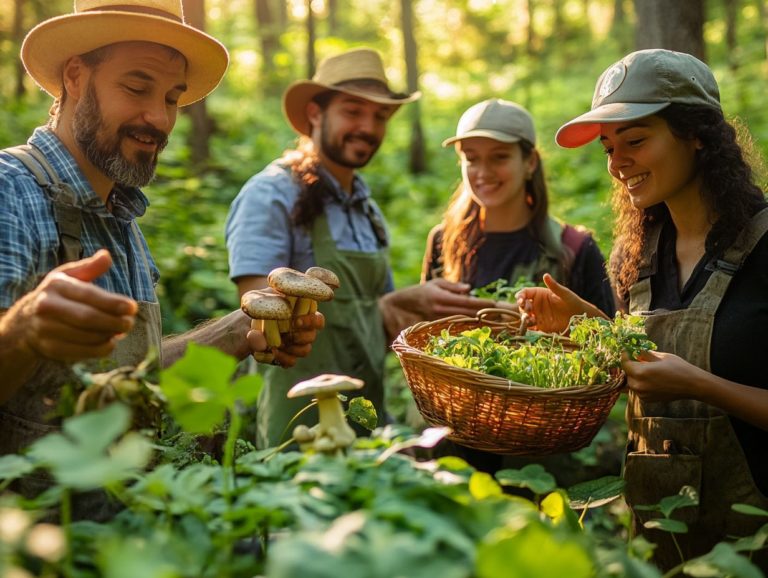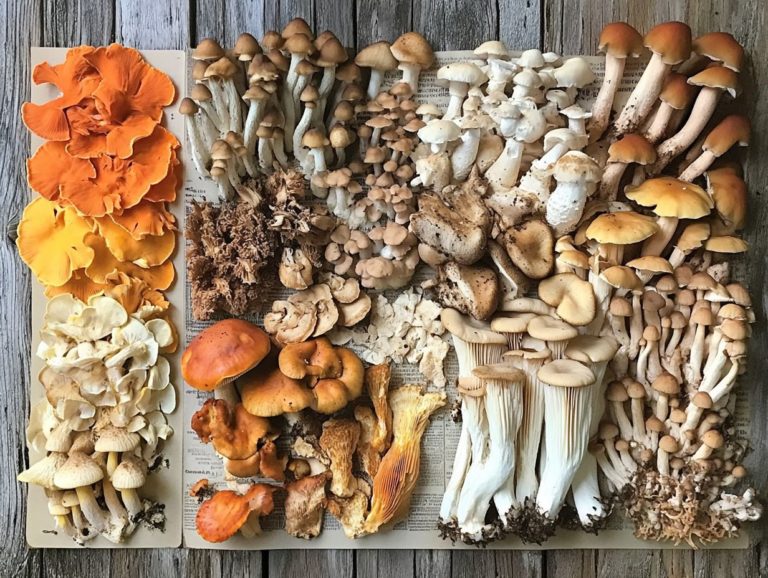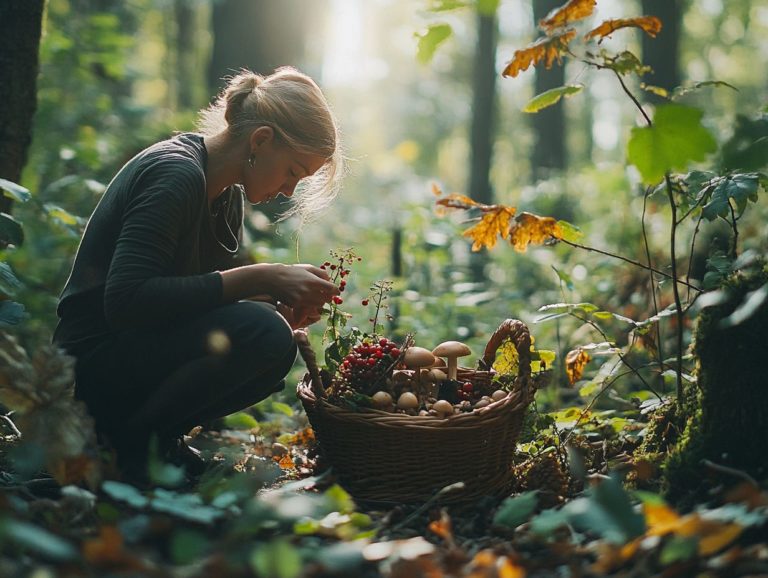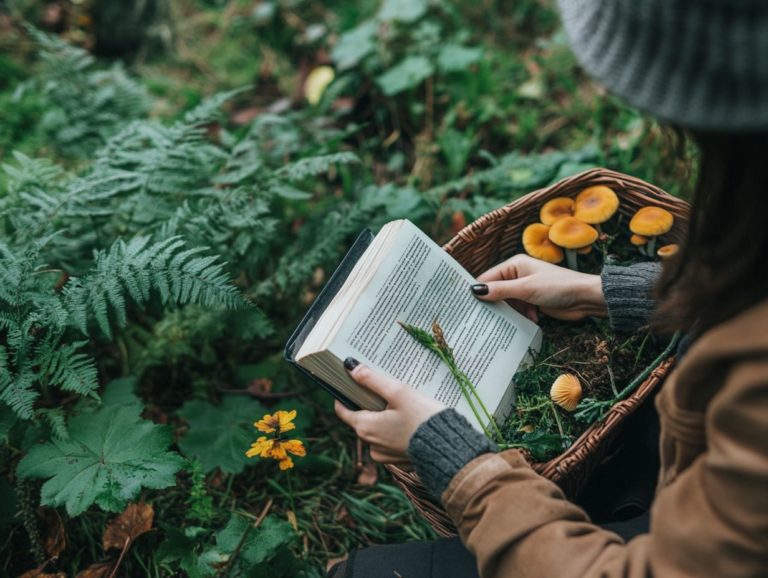How Do I Store My Foraged Finds?
Foraging presents an exquisite adventure, offering a bounty of fresh, flavorful delights straight from the heart of nature. However, the journey doesn t end once you ve gathered your treasures; proper storage is crucial for preserving the freshness, flavor, and safety of wild edible plants.
Discover the exciting world of foraged foods from vibrant greens to luscious berries and understand their unique storage requirements, especially for common varieties like mushrooms and greens. Equip yourself with best practices for cleaning, preparing, and storing your finds, along with preservation techniques that allow you to savor them long after the harvest.
It s vital to spotlight essential safety precautions, especially when identifying wild plants, to ensure your foraging experience remains worry-free. Immerse yourself in the captivating realm of wild food and learn how to keep your cooking finds both safe and delectable!
Contents
- Key Takeaways:
- Why Proper Storage Matters for Your Foraged Foods
- Types of Foraged Foods and Their Storage Needs
- Best Practices for Storing Foraged Finds
- Preserving Foraged Foods for Long-Term Storage
- Safety Precautions for Foraged Foods
- Identifying and Avoiding Poisonous Plants
- Preventing Contamination and Spoilage
- Frequently Asked Questions
- What are some tips for storing my foraged finds?
- How long can I store my foraged finds?
- Do I need to clean my foraged finds before storing them?
- Can I freeze my foraged finds?
- What should I do if I find a potentially poisonous foraged item?
- Are there any precautions I should take when storing my foraged finds?
Key Takeaways:
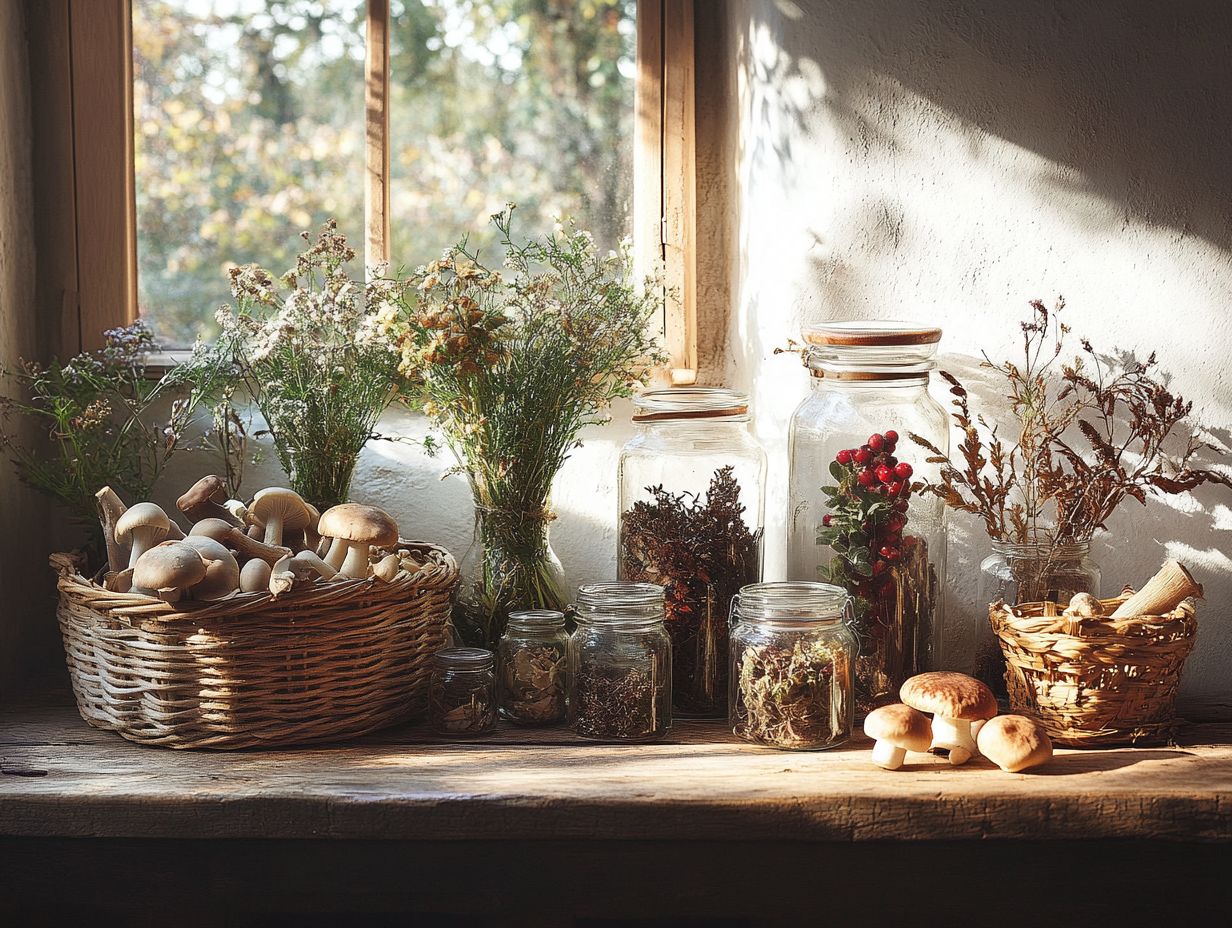
- Store foraged foods properly to keep them fresh and safe.
- Each type of wild plant has its own storage needs know them well!
- Clean and store your finds in airtight containers to lock in freshness.
Why Proper Storage Matters for Your Foraged Foods
In foraging, mastering the art of storing wild edible plants is essential for preserving the freshness and safety of your harvest, especially for cooking greens. Ensuring that treasures like ramps, mushrooms, and dandelions are stored properly enhances their flavors and significantly extends their shelf life. You can learn more about how to preserve edible plants after foraging, allowing you to enjoy them alongside store-bought greens.
Employ techniques like boiling briefly and then cooling in ice water, refrigerating, and freezing wilting items to savor seasonal delights throughout the year, including frozen mushrooms. Additionally, learning how to cook with foraged edibles enhances your experience. Understanding proper storage enables foraging enthusiasts like you to embrace the nutritional benefits of wild edible plants while minimizing waste.
Types of Foraged Foods and Their Storage Needs
As a foraging enthusiast, you have the opportunity to uncover a rich tapestry of wild edible plants, including vegetables like watercress. Each type boasts distinct storage requirements that influence their taste and quality.
Varieties such as nettles, purslane, lamb’s quarters, and garlic mustard require specific preservation methods to maintain their flavor and nutrients. It s crucial to grasp the unique needs of each plant.
Whether you re dealing with cooking greens or fruits like wineberries and cranberries, mastering proper storage will elevate your culinary adventures and minimize spoilage from your seasonal harvest.
Vegetables and Greens
Vegetables and green plants foraged from the wild, like garlic mustard and amaranth, bring a unique flavor profile to your kitchen. They require specific methods to maintain their freshness and quality. Blanching these greens preserves their vibrant colors and nutritional value, making them a delightful addition to any dish.
Properly storing these wild edibles elevates your culinary endeavors. By quickly boiling the greens and then plunging them into ice water, you effectively halt the cooking process, locking in vivid hues and essential vitamins.
Once blanched, dry the greens thoroughly before placing them in airtight containers or plastic containers to avoid frostbite. These methods extend the life of the wild vegetables while maintaining their texture, making them an excellent choice for sauces, soups,, or even dishes featuring maitake mushrooms.
Label your containers with the date to keep track of when your wild finds are at their best, ensuring you enjoy them at peak flavor. Embracing the art of blanching and storing allows you to cultivate a more sustainable kitchen, filled with the bold tastes of nature all year round.
Start your foraging adventure today and enjoy nature s bounty!
Fruits and Berries
Fruits and berries, such as wineberries and cranberries, can improve your foraged menu, but they require careful handling to maximize their flavor and nutritional benefits. To keep them fresh, refrigerate them immediately after harvesting. This simple step will keep your fruits fresh for much longer!
Exploring the world of wild food opens up a treasure trove of delicious options for everything from desserts to savory sauces.
If you want to enjoy seasonal harvests even after their prime, using preservation techniques like freezing, drying, or making jams and jellies can be immensely satisfying. Freezing is particularly effective for retaining both flavor and texture. Drying intensifies the taste, making it ideal for snacks or baking ingredients. Learning how to make preserves not only enhances your wild food experience but also allows you to savor those delightful flavors long after the harvest season has passed.
Nuts and Seeds

Nuts and seeds, like black walnuts and acorn flour, are often underestimated in the foraging realm, yet they have remarkable versatility and nutritional advantages. To preserve their flavor and prevent spoilage, learning how to store them properly is crucial.
Store these foraged gems in airtight containers in a cool, dry environment. This step will greatly extend their shelf life and enhance their usability in various recipes, especially when you know the best way to clean foraged food.
You should also consider freezing them for long-term preservation. This method effectively locks in freshness, especially if you ve gathered larger quantities. For acorn flour, protect it from direct sunlight and temperature swings.
Vacuum sealing is another excellent option for maintaining the quality of more delicate nuts. Regularly check your stash for signs of moisture or pests to ensure these natural treasures remain vibrant, flavorful, and ready to elevate your sweet and savory creations.
Best Practices for Storing Foraged Finds
To keep your foraged treasures fresh and bursting with flavor, it’s essential to adopt best practices for storage. Techniques like blanching greens—a quick cooking method that helps preserve color and flavor before freezing—and using plastic containers can greatly enhance the shelf life of your wild edibles. Additionally, learning how to use foraged ingredients in cooking can further elevate your culinary experience.
By learning the nuances of temperature and humidity management, you can improve how you store your food, ensuring your seasonal harvest remains both delicious and safe for enjoyment.
Cleaning and Preparing for Storage
Cleaning and preparing your foraged foods is an exciting step that enhances their longevity and flavor! Before you think about storage, it’s essential to accurately identify wild plants and document your foraging finds with a thorough rinse to eliminate any dirt or pesticides.
Soaking your greens in water can ensure they are impeccably clean before moving on to blanching or refrigerating them. This meticulous cleaning process not only improves taste but also minimizes the risk of ingesting harmful contaminants.
There are various methods for identifying wild plants, including reliable field guides and specialized mobile apps tailored for foraging enthusiasts. Once you’ve identified your finds, soaking the greens for a brief period can effectively dislodge stubborn soil particles and any small critters hiding among the leaves.
Remember to change the water multiple times if necessary; rinsing the greens under running water adds an extra layer of safety. By prioritizing these essential steps, such as soaking your greens before cooking, you can enjoy your wild harvests with confidence, knowing they are not only flavorful but also impeccably clean.
Ready to dive into foraging? Share your experiences and tips with friends and join the community of foraging enthusiasts!
Choosing the Right Containers
Selecting the right containers for storing your foraged foods is crucial for maintaining their freshness and preventing spoilage.
Plastic containers are often praised for their convenience and effectiveness in food preservation. When you opt for durable and airtight options, you can significantly enhance the storage conditions for your wild edible plants, ensuring that those vibrant flavors and vital nutrients stay locked in.
Beyond plastic, consider materials like glass and stainless steel as standout storage solutions. Glass containers, while a bit heavier, reduce the chance of chemicals getting into your food and excel in longer-term preservation.
Meanwhile, stainless steel options offer remarkable durability and an airtight seal, making them ideal for stashing away mushrooms or wild greens.
Each material boasts its unique advantages, allowing you to choose based on your specific needs be it weight, insulation, or eco-friendliness. By thoughtfully evaluating these options, you can make enlightened choices that extend the life of your foraged treasures.
Proper Temperature and Humidity
Understanding how temperature and humidity affect the storage of foraged foods is crucial for maximizing both their shelf life and flavor, especially for delicate items like mushrooms and wild edible plants.
By maintaining a cool and consistent environment while controlling humidity levels, you can significantly reduce the risk of spoilage in wild edible plants. This knowledge enables you to manage your harvest effectively, allowing you to enjoy those treasures for months.
Using straightforward techniques like airtight containers and ensuring proper air circulation creates a setting where moisture doesn t encourage mold growth, which is vital for preserving the quality of your bounty.
Monitoring humidity levels with devices that measure humidity can be incredibly helpful, and don t underestimate the power of refrigeration for particularly perishable items.
Mastering these parameters helps you savor the rich, earthy flavors of your foraged finds, preventing waste and elevating your culinary experiences throughout the seasons.
Preserving Foraged Foods for Long-Term Storage

Preserving your foraged foods allows you to enjoy nature’s delicious gifts all year round! You can employ a range of techniques, including canning, drying, and freezing.
These methods are crucial for transforming wild ingredients into delightful components for countless recipes. By mastering these preservation techniques, you not only elevate your culinary repertoire but also reduce waste, turning foraging into a truly sustainable practice.
Canning, Drying, and Freezing Techniques
Canning, drying, and freezing are three exceptional techniques that allow you to extend the shelf life of foraged foods, enabling you to savor seasonal harvests all year long.
Each method presents unique benefits tailored to various wild edibles. Canning, for instance, is perfect for fruits and vegetables; it enhances their durability while retaining essential nutrients and vibrant flavors.
This process not only lets you indulge in nature s bounty during the off-season but also simplifies your meal prep.
On the flip side, drying results in a lightweight, shelf-stable product that s ideal for both snacks and meals, concentrating flavors and preserving vitamins. This technique shines particularly with herbs and mushrooms, extending their shelf life while intensifying their taste.
Freezing, meanwhile, is a game-changer for leafy greens and berries, as it locks in their fresh qualities and halts the aging process, ensuring that the lively essence of wild food remains intact for those chillier months.
Safety Precautions for Foraged Foods
Safety is your top priority when foraging for wild edible plants. Accurately identifying these plants can truly mean the difference between enjoying a nutritious meal and facing the risk of poisoning.
Familiarize yourself with poisonous species to confidently know what’s safe and what s harmful. Moreover, adopting proper food handling practices is crucial for making sure your food doesn t get spoiled during storage, ensuring that your foraged treasures remain as delightful as they are safe.
Identifying and Avoiding Poisonous Plants
Identifying and avoiding poisonous plants is essential for your foraging safety. Misidentification can lead to serious health risks. Familiarize yourself with the characteristics of toxic species to distinguish them from safe wild edibles.
Staying informed allows you to enjoy foraging safely while minimizing potential hazards. Your knowledge of local flora is invaluable; it helps you recognize not only the common edible varieties but also their toxic counterparts.
Understanding distinct characteristics like leaf shape, flower color, and habitat is crucial since many dangerous plants can closely resemble safe ones. To enhance your safety, consult reputable guides, such as The Forager Chef s Book of Flora, or join local foraging groups.
Apply the ‘five-rule check’, which means checking five reliable sources before consuming any wild plant. Ultimately, these practices will lay a solid foundation for a rewarding foraging experience while ensuring your health remains intact.
Preventing Contamination and Spoilage
Preventing contamination and spoilage is essential for keeping your foraged foods safe and enjoyable. Implement proper food safety practices: wash your hands before handling anything, use clean containers, and store foods at the right temperature. To enhance your experience, consider exploring what you can make with foraged edibles. Following these guidelines allows you to relish your harvest without the worry of foodborne illnesses.
Be mindful of your foraging environment; avoid areas that may be contaminated, like roadsides or polluted waters. Use insulated bags to keep perishables at a safe temperature during transport, especially for cooking greens and blanching greens.
Properly identifying and separating different types of foraged goods streamlines your process and minimizes the risk of mixing foods, which could cause spoilage or illness. These best practices instill confidence, enabling you to savor the unique flavors and benefits of wild harvests while protecting your health.
Frequently Asked Questions
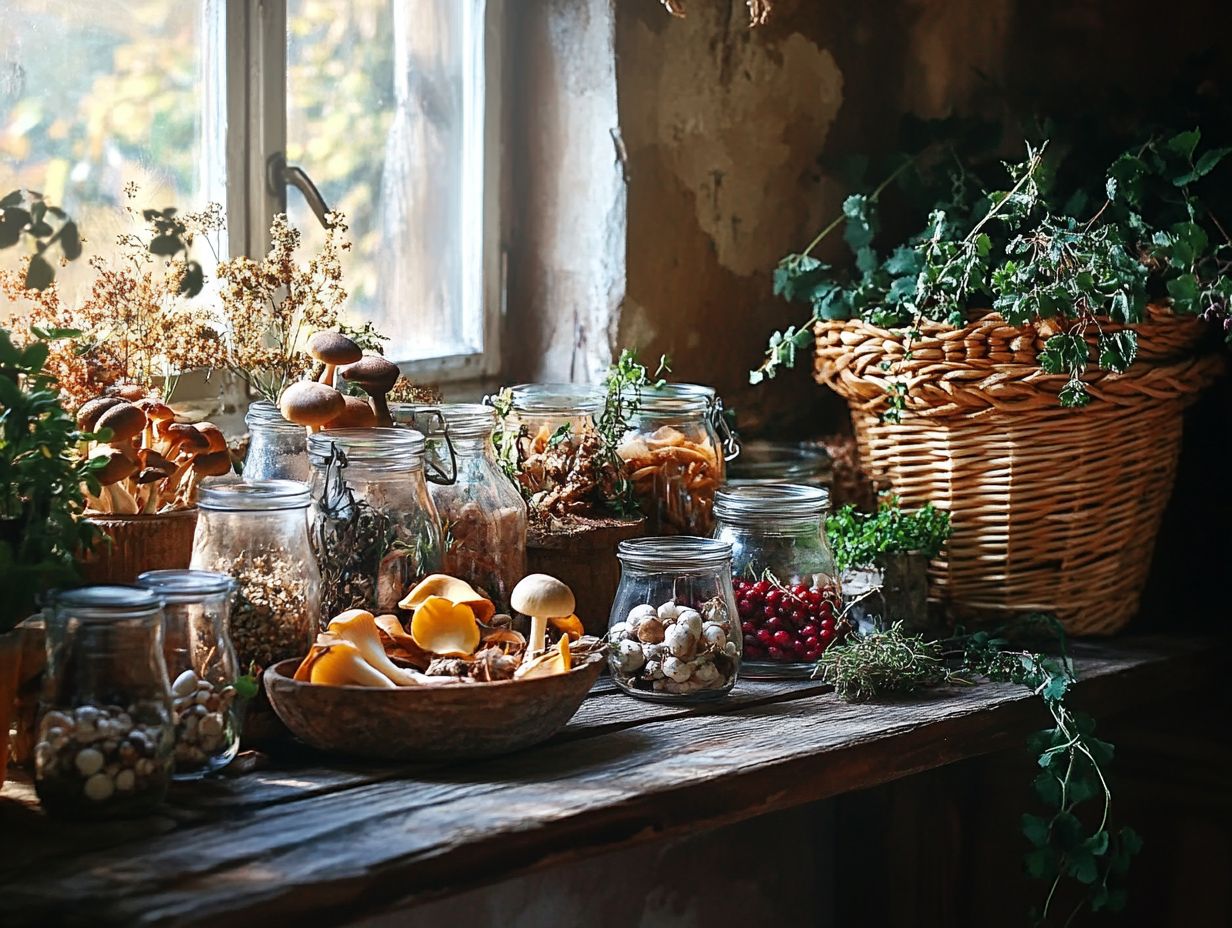
What are some tips for storing my foraged finds?
Keep your foraged finds in a cool, dry place. For more tips, learn how to preserve your foraging finds by using airtight containers or bags and labeling them with the date and location where you found them.
How long can I store my foraged finds?
The storage duration depends on the item. Fresh herbs can last a few days, while dried mushrooms can be stored for several months.
Do I need to clean my foraged finds before storing them?
Yes, cleaning your foraged finds is important. This helps remove any dirt or debris that could cause spoilage or contamination.
Can I freeze my foraged finds?
Yes, many foraged finds can be frozen for long-term storage. This is especially good for items like berries or mushrooms that spoil quickly.
What should I do if I find a potentially poisonous foraged item?
If unsure about the safety of a foraged item, it s best to err on the side of caution and not consume it. Take a photo and consult a local expert or reference guide for identification.
Are there any precautions I should take when storing my foraged finds?
Yes, properly identify and research any foraged item before consuming or storing it. Some items may require specific storage methods to ensure they are safe to eat.

